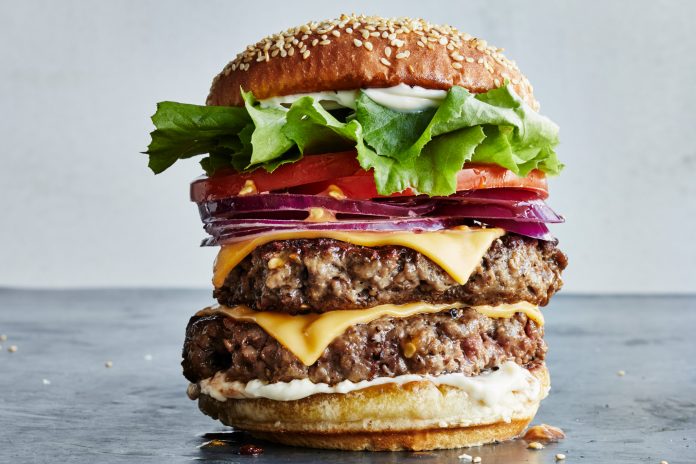Plant-based meat alternatives—products that look, taste, and even sizzle like animal meat—are having a pretty big year. The brands Impossible Foods and Beyond Meat have been scoring headlines, raising impressive amounts of capital, and creating legions of hungry, happy customers: a splashy IPO and partnerships with chains including Carl’s Jr. and TGI Friday’s for Beyond Meat; a $300 million funding round and deals with the likes of Burger King and Cheesecake Factory for Impossible Foods.
You might assume that the surge in popularity of these meat-free products is driven by a rising number of vegetarians in the U.S. But the percentage of Americans who identify as vegetarian has actually ticked down from 6% to 5% over the past 20 years, according to Gallup polls. (The same poll only started tracking rates of veganism in 2012; they’ve risen from 2% to 3% since then.)
In reality, Impossible Foods and Beyond Meat say that their customer bases are just as meat-loving as the general population. Impossible Foods chief communications officer Rachel Konrad tells SELF that over 95% of people who order their burger regularly consume animal products (i.e., aren’t vegan), and that most are not strictly vegetarian either. Beyond Meat boasts similar numbers. “Purchase data from one of the nation’s largest conventional retailers showed that more than 90% of consumers who purchased the Beyond Burger also purchased animal protein,” Will Schafer, the company’s VP of marketing, tells SELF.
The real wonder, then, is how Impossible, Beyond, and similar companies are convincing all these meat eaters to buy into the idea that plant-based is better, at least at some meals. Why are people who enjoy meat shelling out for these meatless products? I talked to experts and looked at research to try to find an answer.
“It seems like it’s better for me.”
Los Angeles resident Kasey L., 23, tells SELF that her family history of heart disease is what spurred her to start eating less meat. “I’m pretty healthy in general, but the amount of [red] meat I was eating was one thing that always worried me in the back of my mind,” Kasey says. “I wanted to cut back, so I gave it a shot once and loved it.” While she still eats meat, she says she’s probably cut her intake by something like 20 percent thanks to the availability of Impossible Burgers and Beyond Burgers at restaurants and retailers.
“From what we have observed, most people choose to eat less meat for health reasons,” Ricardo San Martin, Ph.D., research director of the Alternative Meat Program at the Sutardja Center for Entrepreneurship and Technology at UC Berkeley, tells SELF. “We suspect that people may [be turning] to new meat alternatives in an attempt to foster healthier lifestyles.”
The belief that eating less meat (particularly red meat) may be a boon for health comes from a decent amount of research connecting red meat consumption to negative health outcomes, David A Levitsky, Ph.D., a professor of nutrition and psychology in the Division of Nutritional Sciences and the Department of Psychology at Cornell University, tells SELF. But it’s hard to say whether swapping out beef burgers for these new imitations will actually improve your health or not. The truth is, the research is pretty complicated.
For instance, a massive NIH-funded, Harvard-led study published in the Archives of Internal Medicine in 2012 observing more than 37,000 men and 83,000 women since 1986 and 1980, respectively, found that one additional daily serving of red meat over the course of the study was correlated with a 12% increase in a person’s odds of dying from any cause. Which, of course, sounds scary! But it’s important to note that the researchers did not find a causal link—proof that eating red meat directly leads to higher mortality—only an association.
In 2015 the World Health Organization’s International Agency of Research on Cancer (IARC) did a comprehensive review of more than 800 epidemiological studies investigating associations between red or processed meat consumption and numerous types of cancer, conducted over 20 years across a variety of countries and diets. The review found that there is, indeed, a correlation between red meat consumption and risk of some cancers, but its authors note that the mechanism isn’t clear—it may have something to do with chemicals produced during cooking or processing that are known or suspected carcinogens rather than the meat itself. They also couldn’t rule out other explanations for the association, such as chance, bias, or confounding variables (like other lifestyle and diet choices). Ultimately, though, the connection was enough for them to classify red meat (meaning all mammalian muscle meat, including beef as well as veal, pork, lamb, and mutton) as “probably carcinogenic.” The correlation between red meat and cancer was observed mainly for colorectal cancer, but researchers also saw associations for pancreatic and prostate cancer.
Even major medical organizations have issued recommendations to reduce the intake of red meat. For instance, the American Cancer Society tells us to limit red and processed meat consumption to reduce colorectal cancer risk. And the American Heart Association (AHA) recommends limiting red meat consumption (and minimizing consumption of processed meat—like bacon, hot dogs, and deli slices) on the basis that saturated fat content raisies cholesterol and increases heart disease risk (another subject of confusing nutrition research).
The bottom line: Associations between red meat and poor health outcomes definitely exist and are worth considering, but the research does have its limitations. While the science may not be definitive enough to suggest that everyone should stop eating burgers altogether, for some people—especially those who are at a higher risk for cardiovascular disease or certain types of cancers—choosing plant-based options over cow meat feels like a safe and doable step to potentially reduce your risk of poor health and disease. “People want to do things that are good for them,” Levitsky explains.
So how much healthier are these meatless burgers, really? While the science generally indicates that reducing red meat intake is a good idea, whether the meat alternatives we’re subbing in are actually healthier “is a separate question,” San Martin says. The answer depends on whom you ask (and what you define as “healthy,” of course).
The hamburger’s meatless rivals are mostly composed of plant-based proteins and fats. “These products are being designed to mimic meat, so they contain proteins for chewiness and fats for mouthfeel,” Seattle-based Ginger Hultin, M.S., R.D.N., a spokesperson for the Academy of Nutrition and Dietetics and the AND’s practice group for vegetarian nutrition group, tells SELF. The Impossible Burger is mostly made of soy protein concentrate, coconut oil, and sunflower oil, while the Beyond Burger, on the other hand, is mainly composed of pea protein isolate, canola oil, coconut oil, and rice protein.
Considering they are made of entirely different stuff, the nutrition facts for meat substitutes are surprisingly similar to that of a regular burger in terms of calories, overall fat, saturated fat, and protein content. “As of now, Impossible Foods’ goal is to generally match the nutritional profile of a normal burger,” San Martin explains. (Konrad says, “Our goal is to be at least as nutritious as a burger from cows.”)
For a standard burger comparison, we’ll use the McDonald’s quarter-pounder (just the beef patty), which is 4 ounces and contains 100% beef (not necessarily the case for all hamburgers, btw). It has: 240 calories, 18 g total fat (including 8 g saturated fat and 1 g trans fat), 75 mg cholesterol, 190 mg sodium, 1 g carbs, 0 g fiber, and 20 g protein.
























